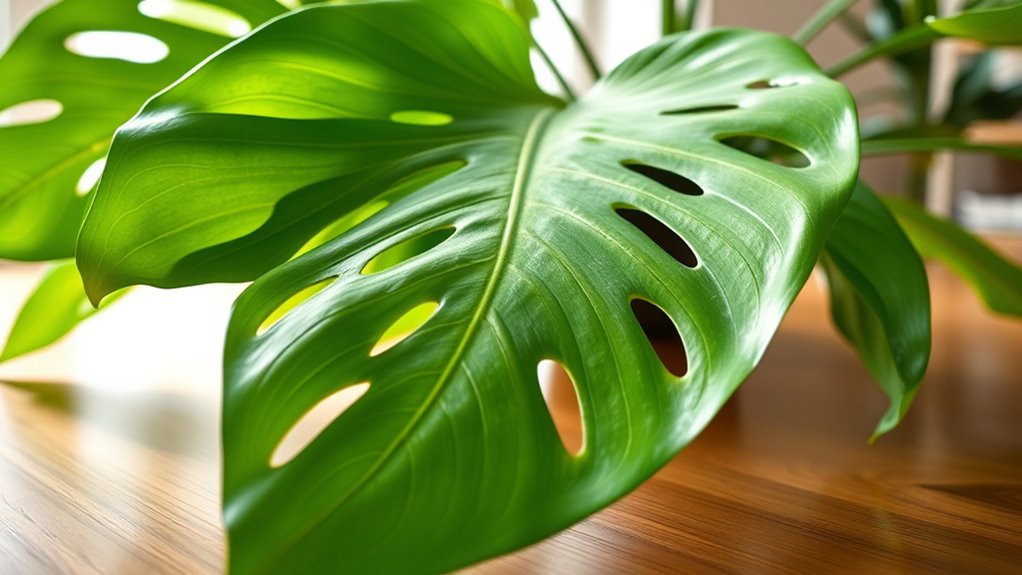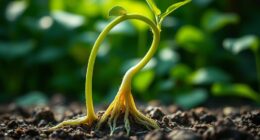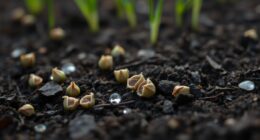To grow big, fenestrated leaves on your Monstera deliciosa indoors, you should water thoroughly when the top inch of soil feels dry, usually every 1-2 weeks, and guarantee excellent drainage. Provide bright, indirect light, and use well-draining soil with peat, perlite, and bark. Maintain consistent watering, monitor for pests, and promote airflow. Following these tips will help your plant thrive and develop those signature split leaves—stay tuned for more expert advice.
Key Takeaways
- Provide bright, indirect light to promote healthy, fenestrated leaves.
- Water thoroughly when the top inch of soil feels dry, adjusting for season.
- Use well-draining soil with peat, perlite, and pine bark to prevent waterlogging.
- Maintain consistent watering and good air circulation to reduce stress and encourage growth.
- Regularly inspect for pests and treat promptly to keep your Monstera healthy and vigorous.

Monstera deliciosa, often called the Swiss cheese plant, is a popular houseplant known for its striking, fenestrated leaves. To keep it healthy and encourage those impressive leaf splits, you need to pay attention to its watering schedule and pest management. When watering, you should aim for a balance: water thoroughly when the top inch of soil feels dry, typically every one to two weeks. Avoid overwatering, as soggy soil can lead to root rot, which is a common issue with Monsteras. During the growing season—spring and summer—you might find yourself watering a bit more frequently, but always check the soil first. In winter, cut back on watering, giving the soil time to dry out more between sessions. Proper watering encourages lush, large leaves and prevents stress that might inhibit fenestration.
Pest management is just as essential in maintaining a big, healthy Monstera. Keep an eye out for common pests like spider mites, mealybugs, and scale. Regularly inspect the undersides of leaves and stems, especially if you notice any yellowing, sticky residue, or tiny webs. If pests appear, act quickly by wiping the leaves with a damp cloth or spraying with insecticidal soap. Isolating the plant during treatment prevents pests from spreading to your other houseplants. Maintaining good air circulation and avoiding overly humid conditions can also reduce pest problems. Remember, healthy plants are less attractive to pests, so proper watering and good overall care create a strong defense.
You should also guarantee the soil drains well, as waterlogged soil can make your plant vulnerable to pests and diseases. Use a pot with drainage holes and a lightweight, well-draining mix—perhaps a blend of peat, perlite, and pine bark. This setup not only prevents excess moisture but also promotes healthy root growth, which is vital for developing those big, fenestrated leaves. Additionally, maintaining consistent care routines helps your Monstera adapt and thrive indoors. By sticking to a reliable watering schedule and keeping pests at bay, you’ll foster a robust plant that produces the large, split leaves you’re aiming for. Remember, patience and attentiveness are key. With proper watering and proactive pest management, your Monstera will flourish, showcasing its signature foliage and adding a stunning tropical vibe to your space.
Frequently Asked Questions
How Long Does It Take for Monstera to Develop Fenestrated Leaves?
You can expect your Monstera to develop fenestrated leaves within 1 to 3 years, depending on growth conditions. As your plant matures and reaches leaf maturity, it begins to produce fenestrations. The fenestration timeline varies based on factors like light, humidity, and pot size. With proper care, your Monstera will start showing those iconic splits and holes, signaling healthy growth and a more mature plant.
Can Monstera Deliciosa Survive in Low-Light Conditions?
Think of your Monstera as a sunlit cloud—bright, vibrant, thriving in good light. It can survive in low-light conditions, but its growth slows and leaves may lose fenestrations. To keep it happy, guarantee it gets indirect light and choose container materials that allow proper drainage. While it tolerates less light, brighter spots bring out its signature fenestrated leaves, making your plant a lush, tropical masterpiece.
What Is the Ideal Watering Schedule for Monstera Indoors?
You should water your Monstera when the top inch of soil feels dry, typically every 1-2 weeks. Adjust the watering frequency based on the moisture levels—if the soil stays wet, wait longer; if it dries out quickly, water more often. Always guarantee proper drainage to prevent overwatering, which can lead to root rot. Consistent moisture levels help your Monstera thrive and develop those big, fenestrated leaves.
How Often Should I Repot My Monstera?
Think of your monstera as a growing star needing space to shine. You should repot every 1-2 years, ideally in spring, to refresh soil nutrients and prevent root bound issues. When repotting, use pruning techniques to trim dead roots and encourage healthy growth. This guarantees your monstera thrives indoors, developing those majestic fenestrated leaves while giving it room to reach its full, lush potential.
Are There Pests That Commonly Affect Monstera Deliciosa?
Yes, common pests like spider mites, mealybugs, and scale insects can affect your Monstera deliciosa. To prevent insects, regularly inspect your plant and keep leaves clean. Use insecticidal soap or neem oil if you notice pests early. Proper watering, good airflow, and avoiding over-fertilization also help ward off infestations. Staying vigilant ensures your Monstera stays healthy and pest-free, promoting lush, fenestrated leaves.
Conclusion
Now that you know how to care for your Monstera deliciosa, get ready to have the most jaw-droppingly massive, fenestrated leaves anyone’s ever seen! With just a little love and the right conditions, your plant will grow so spectacularly big and lush, people will think it’s from a jungle movie. Prepare for serious plant envy from everyone who visits—your indoor jungle will be the envy of all! Happy growing, and watch your Monstera steal the show!










